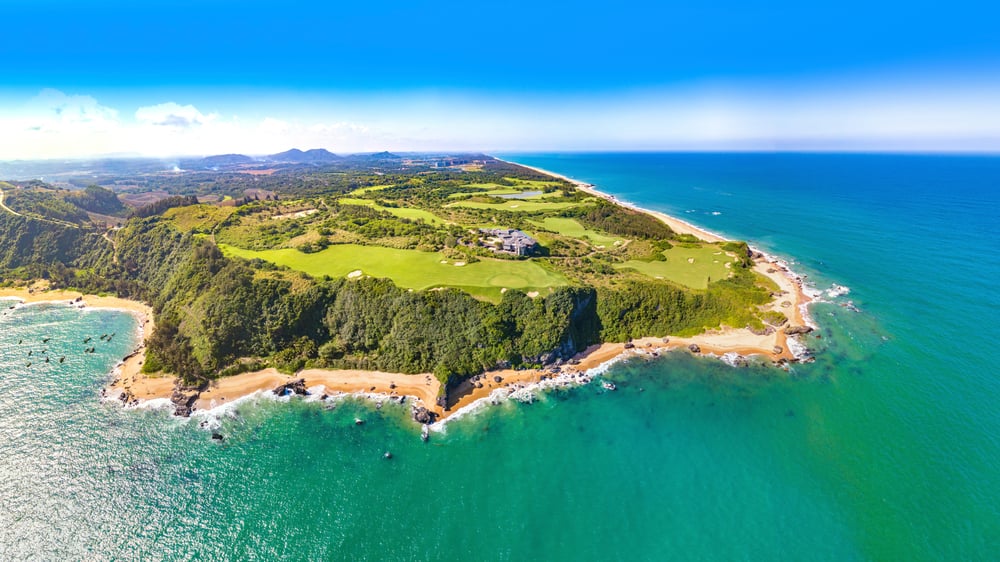Shanqin Bay Golf Club, Hainan: A Coastal Original by Coore & Crenshaw
On Hainan’s southeast coast, near Wanning and the village of Bo’ao, CITIC Shanqin Bay Golf Club sits on a spectacular headland of cliffs, dunes, and jungle that looks out over the South China Sea. Private, perfectly discreet and perennially lauded, it is one of modern golf’s true destination courses – Golf Digest includes it in the World’s 100 Greatest, while GOLF Magazine also ranks it among the world’s top courses. Opened in 2012, it has quietly earned acclaim ever since.

Setting The Scene
Everything about Shanqin Bay feels elemental. The routing occupies a raw sweep of coastline above the South China Sea; inland, fairways thread through ravines and sandy blowouts before bursting back towards the water. The setting – with an official address in Longgun Town – is remote enough to feel secluded, yet reachable from Haikou Meilan International Airport in roughly two hours by road.
A Founder’s Vision, An Audacious Site
It began with a helicopter and a hunch. From above, CITIC chairman Wang Jun traced Hainan’s ragged coastline until a cliff-edged, dune-laced headland south of Bo’ao revealed itself – severe topography, sandy blowouts, and remnants of World War II military fortifications, including stone tunnels. Identifying the site as first-rate ground for golf, he enlisted Bill Coore and Ben Crenshaw – the celebrated American design duo known for minimalist, landscape-led courses such as Sand Hills and Bandon Trails – for their first Asian commission. The result is unmistakably restrained, strategic golf routed over dramatic ground, turning rugged coastal geology and wind into an exacting, minimalist test.
Architecture And Aesthetics
Broad, free-flowing fairways wind through natural ridges and valleys, framed by rugged bunkers and greens that seem to settle effortlessly into the landscape. Shanqin Bay celebrates the raw beauty of its coastal terrain – spare, strategic, and refreshingly untouched by the manicured precision that defines many modern courses. Here, the ever-present South China Sea breeze shapes the day. It turns each round into a test of control and composure, favouring lower, wind-cutting shots and clever use of the ground over sheer distance. Every swing is a small act of calculation – knock-downs that hold their line, run-up approaches that gather softly on the slopes, and fairways that invite a shape before tightening into narrower landing zones. The most rewarding angles come from the quiet side of each hole, where the view of the green opens and the contours ease their challenge. When the air dries and the turf firms, the course reveals its truest character: bump-and-runs drift off slopes, short misses are forgiven, and good judgement outweighs brute strength. In the morning calm, Shanqin Bay reveals its softer side – wide fairways, slower greens, and a quiet sense of ease before the wind takes hold. By late afternoon, the same holes harden under the wind’s weight, demanding patience and precision. Shanqin Bay is golf in its purest form – shaped by nature, refined by design, and always governed by the rhythm of the sea.
Routing Highlights
The closing stretch at Shanqin Bay is as dramatic as it is memorable. The 15th, a long par 4 carved into the cliffs, plays beneath sweeping views of the South China Sea – a hole that balances beauty with precision, demanding a drive that hugs the fairway edge before rising to an elevated green. The 16th follows with a short par 3 that drops more than 50 feet from tee to green. It captures that fleeting stillness after a perfectly struck shot – the quiet moment of shared awe as the ball lifts cleanly into the air and holds its line against the breeze. The 17th is a par 4 that stands apart – it flows beside the shoreline with not a single bunker in sight, relying instead on its natural contours and breeze for challenge. The 18th, a par 4 turns inland, climbing steadily towards a ridge-top green that is shallow, firm, and finely contoured – a closing hole that requires composure rather than force.
Front-Nine Character
Much of the front nine unfolds inland, defined by movement and shape rather than sea spray, though the ocean reveals itself in fleeting glimpses. The 5th hole, a par 4, is a standout – a thoughtful Coore design that traces the edge of a lake before rising over a ridge to a partially hidden green, a hole that rewards precision as much as nerve. The short holes are a delight, especially the beach-side 8th, where the dunes and native grasses showcase the architects’ light touch.
Playing Character
At around 6,900 yards from the tips, Shanqin Bay isn’t long by modern standards, but exposure to the coastal breeze can make it feel far bigger. Fairway bunkering is used sparingly; line, angle, and shot placement take precedence over forced carries. On firm days, the ground game flourishes; on windy ones, mistakes are swiftly exposed. It’s golf that is as strategic as it is scenic – the very essence of the Coore & Crenshaw philosophy.
Clubhouse And Practice
Set high above the coastline, the clubhouse unfolds across two levels and spans roughly 4,500 square metres. Inside, there’s a main restaurant, a 270-degree sea-view room, a leisure bar, and broad terraces that open to uninterrupted views of the South China Sea – a calm, understated space that feels more retreat than resort.
Practice combines a full driving range with dedicated short-game areas near the clubhouse, complemented by separate putting and chipping greens for steady warm-up. Out on the course, the sense of care continues with an impeccable service, the halfway houses appear after the 4th and 12th holes – the soy eggs are something of a local favourite – and the caddie programme is woven into the rhythm of play. Experienced caddies guide through every shift in wind and terrain as the course moves from cliff to valley to dunes, ensuring that each round feels both measured and memorable.
Exclusivity And Access
Shanqin Bay is a private members’ club in the truest sense, being quiet, selective, and almost entirely closed to outside play. Membership is understood to be by invitation only, with access extended solely to members and their personal guests. There are no open days, public listings, or published application details; the club’s privacy is woven into its identity.
Though official figures remain undisclosed, industry estimates consistently place its joining cost among the most exclusive in global golf, with fees said to reach into seven figures. Yet, as with the finest private circles, the true prestige lies in the rarity of entry itself. Shanqin Bay’s prestige rests on its sense of coastal seclusion, shaped by immaculate service and an unspoken code of discretion.
A Lasting Impression
Shanqin Bay’s Members and their guests are treated to what the club calls “shadow service” – a quiet choreography of care in which a personal manager meets arrivals at the airport and discreetly oversees every detail of their stay. It is a service designed to anticipate what members need while preserving the sense of calm that defines the Shanqin experience.
Beneath the surface, history lingers. The course occupies land once home to a World War II barracks and fortress, its routing woven around remnants of fortified walls and stone tunnels. One of these tunnels, running directly beneath the clubhouse, inspired the club’s emblem. For those fortunate enough to walk its fairways, Shanqin Bay represents modern golf architecture distilled to its essence – exacting, elemental, and unforgettable.



